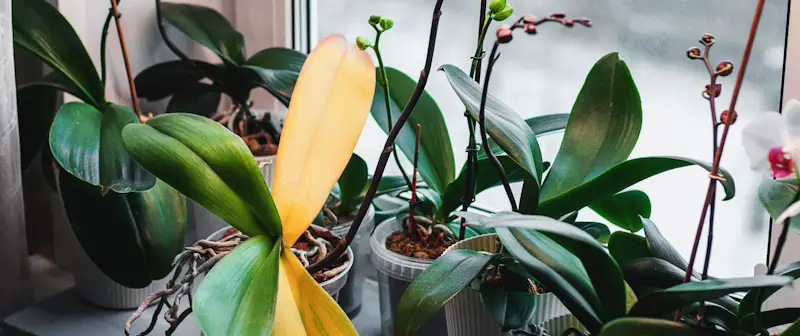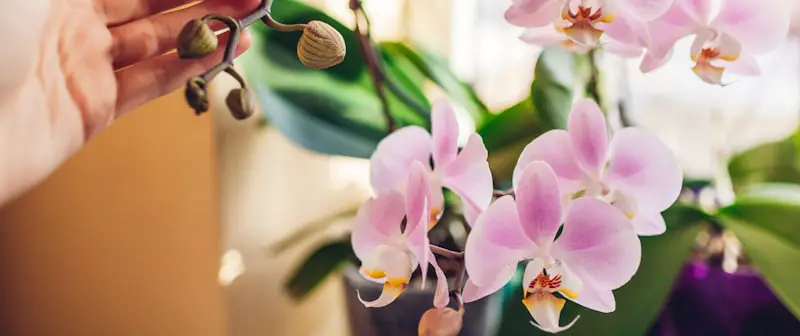You might be wondering – why are my orchid leaves turning yellow? Read more below to find out the causes of yellow orchid leaves and how to take care of them.
Yellow leaves on orchids occur because the roots start dying and can no longer absorb water or nutrients for the orchid. The leaves turn yellow, signifying strain from overwatering or underwatering. Orchid leaves can also turn yellow due to temps lower than 55°F or sunburn.
It’s essential to know the specific causes of yellow leaves on orchids, so you can repair them and prevent any yellowing in the future. In this article, we’ll discuss the reasons orchid leaves start turning yellow.

Why Are My Orchid Leaves Turning Yellow?
Overwatering
Orchid leaves have yellowing due to root rot from overwatering or poorly draining soils. Wet soil withdraws oxygen from orchid roots, causing the roots to die. The dying roots can’t pass the nutrients and water to the orchid, resulting in the leaves turning yellow.
Orchids mature on trees or within loose aggregates instead of in soil. So, they need a ventilated potting medium that lets adequate oxygen levels move to the roots so that they can respirate and work properly. That also means the plants mature in areas with excellent drainage and don’t stand their bases in damp soil.
Watering orchids too much restricts the oxygen surrounding the roots and encourages the circumstances for root rot. Once the roots die, they won’t be able to absorb the water and nutrients into the plant that help maintain the orchids’ healthiness. That results in orchid leaves turning black and yellow due to stress.
Potting mediums that keep too much moisture (like moss and regular potting soil) also create the same issues as overwatering. They restrict the oxygen accessible near the roots, which results in the wilting and dying, causing the leaves to turn yellow.
Drought Stress
Orchid leaves become yellow if you don’t water them enough, use too little water, or if there’s low humidity. Underwatering the plants causes their roots to become white, wilt, and die. The withered, dying roots can’t absorb water and nutrients into the plants, so the leaves turn yellow.
Orchids naturally need watering less frequently than other house plants. Still, the potting medium needs a decent soak each watering to guarantee the plant roots can absorb that moisture and water vapor from the roots’ surrounding air. If the plant has poor watering, only the upper inches of the potting medium are wet when it should be evenly wet to prevent drought.
Usually, orchids require watering once at seven-day intervals during the hot seasons and once at two-week intervals in the cold seasons to reach their watering necessities. Healthy plant roots should look green after watering and have a dull gray color after a week, with a plump feel.
Excess Sun Exposure
A frequent cause for orchid leaves turning yellow at the base is excess direct daylight scorching the leaves. Orchids are natural forest plants that grow under shade out of direct sunshine. The delicate leaves can become yellow due to sunburn if your orchid is near a sunny window.
These plants are adept at growing in forests, so they can’t stand too much sunshine. Still, they can thrive in some sieved light. Preferably, orchids should stay in bright, indirect sunlight since that gives them sufficient energy to flower while preventing injury from sunburn.
Sunburnt leaves look yellow and slightly brown with scorching. The discoloration is most significant on leaves towards the sun. While an orchid as a whole can grow, the sunburnt leaves don’t heal from their scorched damage or become green again.
The burnt leaves also don’t work correctly, so the orchid deteriorates, and leaves frequently turn brown, die and fall off the plant. A sunburnt plant also suffers from drought stress. The penetrating sunlight dehydrates the leaves, potting soil, and roots faster, resulting in wilting leaves and stems and damaged blooms.
Excess Fertilizer
Orchid roots are more fragile than a good number of houseplants. They can burn and die if you use regular houseplant fertilizer. Excess fertilizer causes root burn, which results in them failing. The burnt bases stop absorbing water and nutrients into the plant, so the orchid leaves start turning yellow because of stress.
Orchids aren’t precisely heavy feeders, but specifically prepared plant fertilizer reinforces healthy maturity and promotes flowering. Special orchid fertilizer has the essential nutrients for the plants to thrive. That lessens any risk of root burn or excess salt accumulation in the salt, which interferes with water absorption and turns the orchid leaves yellow.
Orchid fertilizer offers the precise equilibrium of nutrients in the right amounts. If the fertilizer you have is too concentrated or if you use it too much, orchid leaves turn limp and don’t grow any flowers.
Cold Temperatures
Orchids are vulnerable to cold temps and need a temp range of 55°F nightly and an upper limit morning temp of 75°F. While they can stand a few drops in temp below 55°F, a prolonged period under 55°F can result in the plant leaves turning yellow due to stress.
That frequently occurs when the plant is in a breeze or near a chilly window, mainly if the leaves touch the cold window panes. Lower temps also result in the plant’s potting soil staying moist for an extended period, which encourages the progression of root rot.
Orchids are hardier than you’d think. Still, sadly, it’s harder to heal an orchid with cold damage because of its sensitivity to the low temps. The success of recovery relies on the damage to the plant. An orchid is likely to die and not heal with severe damage, but it can recover from slight injuries to just a few leaves.
To give the plant the most excellent chance of survival, keep it in a room with maintained temps between 55-75°F. Practice the proper care practices, like watering once every seven to fourteen days and keeping the plant in a space with bright, indirect sunlight.
Don’t use fertilizer if the orchid has damage since it encourages plant growth when it is already under stress. The plant should recover if new foliage grows in the hot season.

Repotting
The most frequent cause of yellow orchids after repotting is relocation shock or planting in soil that contains a lot of moisture. Yellow leaves on orchids confirm stress from fluctuating temps, excess moisture, poor ventilation, inadequate sunlight exposure, or excess water surrounding the roots.
Repotting or transplanting an orchid can change a plant’s environment, affecting its ideal conditions. To protect it, you should correct the environmental factors impacting the stress.
Orchids require repotting once at two or three years since the roots need specifically aerated soil to let oxygen flow through the bases to respire. Pine bark chips are the ideal potting medium for these plants due to their ventilated, absorbent structure that provides decent drainage and maintains the roots’ healthiness.
Suppose you move an orchid into moss or another potting soil. In that case, the mediums hold a large amount of moisture surrounding the roots, which deprives the roots of oxygen. Orchid leaves turning yellow after repotting means that the plant can eventually die.
So, always pot these orchids in pine bark chips (or other bark-based potting mediums) for healthy plants instead of moss or regular potting soil. It’s also crucial to keep the plants in an appropriate pot. It would be best if you always grew them in pots with drainage holes.
You can also use a decorative external pot or keep the orchids on trays or dishes to avoid water spillage. In that situation, it’s imperative to clear out the saucer to get rid of excess water regularly since the roots can’t handle soil saturation.
Your orchid should stay in bright, indirect sunlight at temps between 55-75°F, hydrated with a decent soak once every seven to fourteen days. Ensure that the plant occasionally stays out of draughts and mist to make a humid micro-environment. Then, the plant should adjust after repotting after a few weeks.
Final Words
That’s it for the causes of orchid leaves turning yellow. You need to be aware of the different factors and know how to tackle each one to take proper care of your orchids. Then, your garden can be full of them with time. Enjoy!
Victoria is the owner and main author of hobby plants. She loves spending her free time in her garden planting and taking care of her plants. Victoria hopes you enjoy the content here!
![Why Is My Bamboo Plant Turning Yellow? [Find Out Here] Why Is My Bamboo Plant Turning Yellow? [Find Out Here]](https://www.hobbyplants.com/wp-content/uploads/2022/07/why-is-my-bamboo-turning-yellow-300x158.jpg)
![Why Is My Aloe Plant Turning Brown? [FIND OUT HERE] Why Is My Aloe Plant Turning Brown? [FIND OUT HERE]](https://www.hobbyplants.com/wp-content/uploads/2022/07/why-is-my-aloe-plant-turning-brown-300x158.jpg)
![Why Are My Bird of Paradise Leaves Curling? [FIND OUT HERE] Why Are My Bird of Paradise Leaves Curling? [FIND OUT HERE]](https://www.hobbyplants.com/wp-content/uploads/2022/07/bird-of-paradise-leaves-curling-300x158.jpg)
![How To Propagate Bird Of Paradise? [Find Out Here] How To Propagate Bird Of Paradise? [Find Out Here]](https://www.hobbyplants.com/wp-content/uploads/2022/08/how-to-propagate-bird-of-paradise-300x158.jpg)
![How Often Do You Water A Snake Plant? [FIND OUT HERE] How Often Do You Water A Snake Plant? [FIND OUT HERE]](https://www.hobbyplants.com/wp-content/uploads/2022/07/how-often-do-you-water-a-snake-plant-1-300x158.jpg)
![How Big Do Different Types Of Azaleas Get? [Find Out Here] How Big Do Different Types Of Azaleas Get? [Find Out Here]](https://www.hobbyplants.com/wp-content/uploads/2022/09/how-big-do-azaleas-get-300x158.jpg)

![Why Are My Peace Lily Leaves Turning Brown? [EXPLAINED] Why Are My Peace Lily Leaves Turning Brown? [EXPLAINED]](https://www.hobbyplants.com/wp-content/uploads/2022/07/peace-lily-leaves-turning-brown-1-300x158.jpg)
![Why Is My Fiddle Leaf Fig Dropping Leaves? [ANSWERED] Why Is My Fiddle Leaf Fig Dropping Leaves? [ANSWERED]](https://www.hobbyplants.com/wp-content/uploads/2022/06/why-is-my-fiddle-leaf-fig-dropping-leaves-300x158.jpg)


